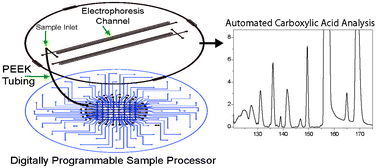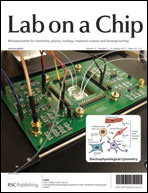A digitally programmable microfluidic Automaton consisting of a 2-dimensional array of pneumatically actuated microvalves is programmed to perform new multiscale mixing and sample processing operations. Large (μL-scale) volume processing operations are enabled by precise metering of multiple reagents within individual nL-scale valves followed by serial repetitive transfer to programmed locations in the array. A novel process exploiting new combining valve concepts is developed for continuous rapid and complete mixing of reagents in less than 800 ms. Mixing, transfer, storage, and rinsing operations are implemented combinatorially to achieve complex assay automation protocols. The practical utility of this technology is demonstrated by performing automated serial dilution for quantitative analysis as well as the first demonstration of on-chip fluorescent derivatization of biomarker targets (carboxylic acids) for microchip capillary electrophoresis on the Mars Organic Analyzer. A language is developed to describe how unit operations are combined to form a microfluidic program. Finally, this technology is used to develop a novel microfluidic 6-sample processor for combinatorial mixing of large sets (>26 unique combinations) of reagents. The digitally programmable microfluidic Automaton is a versatile programmable sample processor for a wide range of process volumes, for multiple samples, and for different types of analyses.

You have access to this article
 Please wait while we load your content...
Something went wrong. Try again?
Please wait while we load your content...
Something went wrong. Try again?


 Please wait while we load your content...
Please wait while we load your content...